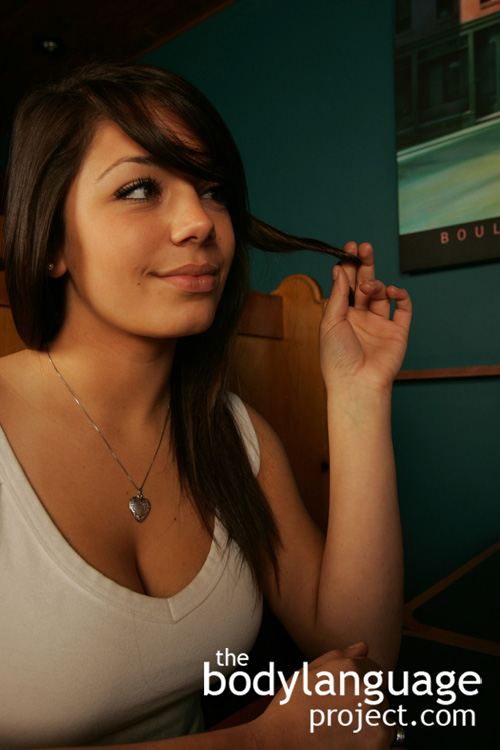What Do Hugs Mean? The Different Kinds of Hugs Body Language

Note a friendly hug by the distance between the hips. We don’t press against our friends and family members.
Cue: Hug
Synonym(s): a) Abrazo, b) Bear Hug c) Buddy Hug d) Sleepy Shoulder Hug e) Quickie Hug f) Unreciprocated Hug g) Cuddle Hug h) Squeeze Hug i) Waist Hug.
Description:
a) The Abrazo is done by pressing the chests together and engulfing the back of the other person with the arms.
b) The Bear Hug is a loving but hard and firm huge that can be done between men and women, two men, two women or an adult and child.
c) The Buddy Hug is a hug that is between friends where each person pats the back of the other.
d) The Sleepy Shoulder Hug is when two people cuddle up to one another and one person rests against the other’s shoulder.
e) The Quickie Hug is a brief hug that is brief where one or both parties quickly splits from the hug and heads off.
f) The Unreciprocated Hug happens with only one full participant. The other person usually stands stiff with their arms to their sides or barely hugs back.
g) The Cuddle Hug happens when one person rests against the other’s shoulder, usually while seated watching television, a movie or at the park.
h) The Squeeze Hug is less than a bear hug but still firm.
i) The Waist Hug happens usually while standing where one arm is wrapped around the waist of another.
In One Sentence: Hug variations help define relationships.
How To Use it: See other sections with help in applying the various hug types.
Context: General.
Verbal Translation:
a) [Abrazo] “I like you so I’m pressing my chest against you.”
b) [Bear Hug] “I really like you a lot and adore you and want to show how much I care by squeezing you tightly.”
c) [Buddy Hug] “We can be friends, but I don’t want to date you.”
d) [Sleepy Shoulder Hug] “I like you, but more importantly, I feel safe in your arms so I’m going to rest my head against your strong shoulder.”
e) [Quickie Hug] “I really need to be someplace else so let’s just hug quickly so I can get out of here.”
f) [Unreciprocated Hug] “I’m not interested in hugging you, we don’t see eye-to-eye so I’m just going to let my arms go limply to the side as you hug me.”
g) [Cuddle Hug] “I want to feel safe in your arms and so I’m snuggling up against you.”
h) [Squeeze Hug] “We have fun together, we should do this again.”
i) [Waist Hug] “We are an item, attached at the hip, and walk as one.”
Variant: There are two main variants to hugs. They are the light social hug and the intimate hug. The Light Social Hug or the Polite Hug is used for acquaintances and friends, and happens when the shoulders come together but the hips remain separated and do not press together. It is where only the minimum amount of touching is present and most certainly not the hips. In The Intimate Hug, the hips come together and press together. It signals romantic or sexual interest. It is common in lovers.
Cue In Action:
a) [Abrazo] When Dad and Son were reunited from across the ocean, they hugged each other with by engulfing each other with their arms.
b) [Bear Hug] Dad gave his son a big bear hug after picking him up from school.
c) [Buddy Hug] At the end of the date, she hugged him and patted him on the back.
d) [Sleepy Shoulder Hug] While waiting for the bus, she rested her head against his shoulder.
e) [Quickie Hug] The bus was about the leave so she quickly hugged her boyfriend before bounding off to catch it.
f) [Unreciprocated Hug] He hugged his wife, but her arms were limp, she expected an apology.
g) [Cuddle Hug] The couple snuggled up on the couch together for popcorn and a movie.
h) [Squeeze Hug] At the end of the play date, the kids all lightly hugged each other before meeting up with their parents.
i) [Waist Hug] The couple enjoyed a beautiful sunset while embracing at the hip.
Meaning and/or Motivation:
a) [Abrazo] A term originating in Latin America that describes a brief hug between men.
b) [Bear Hug] Means that a person really likes and cares for someone else and wants to be close to them.
c) [Buddy Hug] A hug that is light on intimacy hence the patting (which aims to break the hug up) but is rich in camaraderie and friendship. When in a dating context it shows that intimacy is lacking and is replaced with more friendship.
d) [Sleepy Shoulder Hug] Indicates a desire for closeness through protection.
e) [Quickie Hug] Means that people are short on time and need to be someplace else.
f) [Unreciprocated Hug] This is the cold shoulder. It means that a person is not happy and doesn’t have much in common with the hugger or is holding a grudge.
g) [Cuddle Hug] Indicates the desire to be, and feel, protected.
h) [Squeeze Hug] A tight hug showing that fun was had but it is devoid of passion.
i) [Waist Hug] Denotes two people that are an item and whom want others to recognize them as such.
Cue Cluster: N/A
Body Language Category: Courtship display, Friendship touching or friendly touching.
Resources:
Bowlby, J. (1979). The making and breaking of affectional bonds. British Journal of Psychiatry, 130, 201 -210, 42 1-43 1 .
Broome, Marion E.. Helping Parents Support Their Child In Pain. Pediatric Nursing. 2000. 26(3): 315.
Bernal, Gilda Rios ; Wortham, Suec. How to Calm Children through Massage. Childhood Education. 1997. 74(1): 9-14.
Bohm. 1997. Effects of interpersonal touch, degree of justification, and sex of participant on compliance with a request. The Journal of social psychology. 137: 460-469.
Derlega, Valerian ; Lewis, Robin ; Harrison, Scott ; Winstead, Barbara ; Costanza, Robert. Gender differences in the initiation and attribution of tactile intimacy. Journal of Nonverbal Behavior. 1989. 13(2): 83-96.
Derlega, Valerian J. ; Catanzaro, Diane ; Lewis, Robin J. Lisak, David (editor). Perceptions About Tactile Intimacy in Same-Sex and Opposite-Sex Pairs Based on Research Participants’ Sexual Orientation. Psychology of Men & Masculinity, 2001, Vol.2(2), pp.124-132
Debrot, Anik ; Schoebi, Dominik ; Perrez, Meinrad ; Horn, Andrea B. Touch as an interpersonal emotion regulation process in couples’ daily lives: the mediating role of psychological intimacy. Personality & social psychology bulletin. 2013. 9(10): 1373-85.
Dickinson, Amy. Block That Hug: The rules on touching children have changed for parents who volunteer as coaches or tutors.(Personal Time/Your Family)(Brief Article). Time. 2000. 155(14): 142.
Fisher, J; Rytting, M and Heslin, R. 1976. Hands touching hands: affective and evaluative effects on interpersonal touch, Sociometry 39: 416–421.
Feldman, R., Singer, M.,& Zagoory, O. (2010). Touch attenuates infants’ physiological reactivity to stress. Developmental Science, 13(2), 271–278.
Fromme, Donald ; Jaynes, William ; Taylor, Deborah ; Hanold, Elaine ; Daniell, Jennifer ; Rountree, J. ; Fromme, Marie. Nonverbal behavior and attitudes toward touch. Journal of Nonverbal Behavior. 1989. 13(1): 3-14.
Flores, Luis E. ; Berenbaum, Howard. Desire for emotional closeness moderates the effectiveness of the social regulation of emotion. Personality and Individual Differences
Floyd, Kory. All Touches are not Created Equal: Effects of Form and Duration on Observers’ Interpretations of an Embrace. Journal of Nonverbal Behavior. 1999. 23(4): 283-299.
Guéguen, N. (2007). Courtship compliance: The effect of touch on women’s behavior. Social Influence, 2, 81-97.
Gueguen, Nicolas. The effect of a woman’s incidental tactile contact on men’s later behavior.(Report). Social Behavior and Personality: an international journal. 2010. 38(2): 257(10).
Guéguen, Nicolas. Nonverbal encouragement of participation in a course: the effect of touching Social Psychology of Education. 2004. 7: 89–98.
http://bodylanguageproject.com/articles/a-touching-way-to-encourage/
Gurevitch, Z. D. The Embrace: On the Element of Non-Distance in Human Relations. The Sociological Quarterly. 1990. 31(2): 187-201.
Golden, Deborah. Hugging the Teacher: Reading Bodily Practice in an Israeli Kindergarten. Teachers and Teaching: Theory and Practice. 2004. 10(4): 395-407.
Gulledge, Andrew K ; Stahmann, Robert F ; Wilson, Colwick M. Seven types of nonsexual romantic physical affection among Brigham young university students
Psychological reports 2004, Vol.95(2), pp.609-14
Gulledge, Andrewk. ; Gulledge, Michelleh. ; Stahmannn, Robertf. Romantic Physical Affection Types and Relationship Satisfaction. The American Journal of Family Therapy, 2003, Vol.31(4), p.233-242
Greenbaum, Paul ; Rosenfeld, Howard. Varieties of touching in greetings: Sequential structure and sex-related differences. Journal of Nonverbal Behavior. 1980. 5(1): 13-25.
Gulledge, Andrewk. ; Gulledge, Michelleh. ; Stahmannn, Robertf.. Romantic Physical Affection Types and Relationship Satisfaction. The American Journal of Family Therapy. 2003. 31(4): 233-242.
Gulledge, Andrew K ; Stahmann, Robert F ; Wilson, Colwick M. Seven types of nonsexual romantic physical affection among Brigham young university students. Psychological reports. 2004. 95(2): 609-14.
Hansen, Jacqueline. Teaching without talking: teachers need to be aware of more than just the words they speak to children. They also need to monitor the nonverbal messages that they’re sending to students through proximity, eye contact, gestures, and touching. Phi Delta Kappan. 2010. 92(1): 35(6).
Hosey, Geoffrey ; Thompson, Robin. Grooming and touching behaviour in captive ring-tailed lemurs ( Lemur catta L.). Primates. 1985. 26(1): 95-98.
Hazan, C., & Shaver, P. (1987). Romantic love conceptualized as an attachment process. Journal of Personality and Social Psychology, 52, 511–524.
Hansen, Jacqueline. The Truth about Teaching and Touching. Childhood Education. 2007. 83(3): 158-162.
Hadi, Rhonda ; Valenzuela, Ana. A meaningful embrace: Contingent effects of embodied cues of affection. Journal of Consumer Psychology, 2014, Vol.24(4), pp.520-532
Heino, William J. Perfect Timing for Parental Hugs.(to comfort children following medical treatment)(Brief Article). Consultant. 2000. 40(13): 2173.
Hugs help protect against stress and infection, say Carnegie Mellon researchers.(Report)
Health & Medicine Week, Jan 2, p.1341
Hernandez-Reif, Maria ; Diego, Miguel ; Field, Tiffany. Preterm infants show reduced stress behaviors and activity after 5 days of massage therapy. Infant Behavior and Development. 2007. 30(4): 557-561.
Harrison, Lynda Law. The use of comforting touch and massage to reduce stress for preterm infants in the neonatal intensive care unit. Newborn and Infant Nursing Reviews. 2001. 1(4): 235-241.
Hennessy, Michael B ; T. Williams, Michael ; Miller, Deborah D ; Douglas, Chet W ; Voith, Victoria L. Influence of male and female petters on plasma cortisol and behaviour: can human interaction reduce the stress of dogs in a public animal shelter?
Applied Animal Behaviour Science. 1998. 61(1): 63-77.
Kammers, Marjolein P.M. ; de Vignemont, Frédérique ; Haggard, Patrick. Cooling the Thermal Grill Illusion through Self-Touch. Current Biology. 2010. 20(20): 1819-182.
Karagozoglu, Serife ; Kahve, Emine. Effects of back massage on chemotherapy-related fatigue and anxiety: Supportive care and therapeutic touch in cancer nursing. Applied Nursing Research. 2013. 26(4): 210-217.
Landau, Rivka. Affect and attachment: Kissing, hugging, and patting as attachment behaviors. Infant Mental Health Journal. 1989. 10(1): 59-69.
Larsen, Knuds. ; Leroux, Jeff. A study of same sex touching attitudes: Scale development and personality predictors. Journal of Sex Research. 1984. 20(3): 264-278.
Moszkowski, Robin J. ; Stack, Dale M. ; Girouard, Nadine ; Field, Tiffany M. ; Hernandez-Reif, Maria ; Diego, Miguel. Touching behaviors of infants of depressed mothers during normal and perturbed interactions. Infant Behavior and Development. 2009. 32(2): 183-194.
Maclaren, Kym. Touching matters: Embodiments of intimacy. Emotion, Space and Society. 2014. 13: 95-102.
Madden, Myron. Meaningful pastoral intimacy. Pastoral Psychology. 1976. 25(1): 34-38.
Maclaren, Kym. Touching matters: Embodiments of intimacy. Emotion, Space and Society. 2014. 13: 95-102.
Moore, Monica. Courtship Signaling and Adolescents: Girls Just Wanna Have Fun. Journal of Sex Research. 1995. 32(4): 319-328.
http://bodylanguageproject.com/articles/girls-just-want-to-have-fun-the-origins-of-courtship-cues-in-girls-and-women/
Moszkowski, Robin J. ; Stack, Dale M. ; Chiarella, Sabrina S. Infant touch with gaze and affective behaviors during mother–infant still-face interactions: Co-occurrence and functions of touch. Infant Behavior and Development. 2009. 32(4): 392-403.
Nelson, Holly ; Geher, Glenn. Mutual Grooming in Human Dyadic Relationships: An Ethological Perspective. Current Psychology. 2007. 26(2): 121-140.
O’sullivan, Lucia F. ; Cheng, Mariah Mantsun ; Harris, Kathleen Mullan ; Brooks-gunn, Jeanne. I Wanna Hold Your Hand: The Progression of Social, Romantic and Sexual Events in Adolescent Relationships. Perspectives on Sexual and Reproductive Health. 2007. 39(2): 100-107.
Paulsell, Shari ; Goldman, Morton. The Effect of Touching Different Body Areas on Prosocial Behavior. The Journal of Social Psychology. 1984. 122(2): 269-273.
Peck, J., & Shu, S. B. (2009). The effect of mere touch on perceived ownership. Journal of Consumer Research, 36(Oct), 434–447.
Rabinowitz, Fredric E. The male-to-male embrace: breaking the touch taboo in a men’s therapy group. Journal of Counseling and Development. 1991. 69(6): 574(3).
Remland, Martins. ; Jones, Tricias. ; Brinkman, Heidi. Interpersonal Distance, Body Orientation, and Touch: Effects of Culture, Gender, and Age. The Journal of Social Psychology. 1995 135(3): 281-297.
Rubin, Mark Morrison, Todd G. (editor). Social Affiliation Cues Prime Help-Seeking Intentions. Canadian Journal of Behavioural Science/Revue canadienne des sciences du comportement. 2011. 43(2): 138-141.
Rempel, J., Holmes, J., & Zanna, M. (1985). Trust in close relationships. Journal of Personality and Social Psychology, 49, 95–112.
Shimooka, Yukiko ; Nakagawa, Naofumi. Functions of an unreported “rocking-embrace” gesture between female Japanese Macaques ( Macaca fuscata ) in Kinkazan Island, Japan. Primates. 2014. 55(2): 327-335.
Shelton, Kathryn ; Mckenzie, Richard B. Pedophiles and the regulation of hugging: concerns about protecting children may deprive them of important physical contact.(PUBLIC SAFETY). Regulation. 2012. 35(4): 14(5).
Shimooka, Yukiko ; Nakagawa, Naofumi. Functions of an unreported “rocking-embrace” gesture between female Japanese Macaques ( Macaca fuscata ) in Kinkazan Island, Japan. Primates. 2014. 55(2): 327-335.
Toronto, Ellen L.K. A clinician’s response to physical touch in the psychoanalytic setting. International Journal of Psychotherapy. 2002 7(1): 69-81.
Takeuchi, Mika ; Miyaoka, Hitoshi ; Tomoda, Atsuko ; Suzuki, Masao ; Liu, Qingbo ; Kitamura, Toshinori. The Effect of Interpersonal Touch During Childhood on Adult Attachment and Depression: A Neglected Area of Family and Developmental Psychology? Journal of Child and Family Studies. 2010. 19(1): 109-117.
Taavoni, S ; Shahali, S ; Haghani, H. Infant Vaccination Pain Management: Comparing the Effect of Mother’s Hug and Breast Feeding, Tehran, 2009-2010. Pediatric Research. 2011. 70: 738-738.
Tracy, R. L., & Ainsworth, M. D. S. (1981). Maternal affectionate behavior and infant-mother attachment patterns. Child Development, 52, 1341-1343.
Williams, Trish ; Connolly, Jennifer ; Cribbie, Robert. Light and Heavy Heterosexual Activities of Young Canadian Adolescents: Normative Patterns and Differential Predictors.(Author abstract)(Report). Journal of Research on Adolescence. 2008. 18(1): 145(28).
Willis, Frank N. , Jr. ; Dodds, Rebecca A. Age, relationship, and touch initiation. The Journal of Social Psychology. 1998. 138(1). 115(9).












